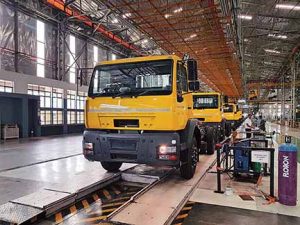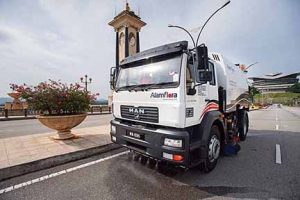MAN Trucks India is investing in new initiatives to grow faster than the industry.
Story by: Bhushan Mhapralkar
To create brand awareness MAN Trucks India ran an expedition that saw five MAN trucks travel from various parts of India to Pithampur (Indore) where the CV maker has a manufacturing plant since 2005. The culmination of the journey at Pithampur saw the five trucks clock 9,884 kms cumulatively and mark the company’s focus on long-haul segments. Aspiring to grow faster than the industry, MAN Trucks India also announced new initiatives to increase its market reach. In an environment where the effect of GST is beginning to show, the company is banking on the growth of tractor-trailer segments as transporters look for better productivity and profitability. Offering trucks (and bus chassis) in the 16- to 49-tonne category, the company is closely watching the emergence of rated payload. Announced Joerg Mommertz, Chairman and Managing Director, MAN Trucks India, that they want to be a part of sustainable CV industry growth. He expressed, “The GDP grows, the CV industry will grow.” Emphasising on providing best products, Mommertz mentioned, “We are confident of the CLA Evo trucks addressing the changing needs of fleet operators in terms of payload and efficiency.” Strengthening its network by rolling out new customer-centric features that will make operating a MAN truck advantageous, the company is also expanding the number of dealers.
Advantage customer
Aware of the need to satisfy the operator’s equation for Rupee-per-km cost, MAN Trucks India is set to increase its presence beyond 65 locations pan-India. With four touch-points in South India, the company will be soon announcing the commissioning of five new dealerships. In-line with the changing needs of customers post BSIV, the CV maker will also roll out Mobile24 in 2018. It is a 24×7 roadside assistance service that will assure the operator of maximum uptime. To offer maintenance contracts that are customised to suit specific customer needs, the company will also roll out a programme to train drivers to operate safely and efficiently in 2018. It is called the ‘ProfiDrive’, and is derived from 35 years of the company’s experience in this space. Apart from coupling ‘ProfiDrive’ with customised AMC offerings, MAN Trucks India is also looking at easy financing schemes to guarantee customers competitive lifecycle costs. With the demand for telematics increasing, the company will offer solutions that will help its customers to clock higher efficiency and profitability.
Not intending to penetrate segments below 16-tonnes even though it has products below 16-tonne on offer in some other markets of the world, including the TGE van, the company, said Mommertz, has a clear heavy vehicle strategy in place. Selling over 4500 units last year, MAN Trucks India is keen to increase its reach in all the segments above 16-tonnes. Avoiding segments below 16-tonnes as they fail to make a compelling case for return on investment, the CV maker is keen to carve out a greater pie of the commercial vehicle market in the country. Enjoying a good rapport in the construction and mining truck market, MAN Trucks India, mentioned Mommertz, is looking at sustained growth. Drawing attention to the CV market growth last year on a small base, he stated, “the need is for sustainable growth.” With regulations playing a role, Mommertz is also banking on factors that are influencing the logistics industry. Stressing upon the need to feed high inventory levels to the assembly line, Mommertz expressed, “A change in legislation to register the tractor and trailer as individual entities will lead to higher flexibility. Our customers are also demanding it.” Of the opinion that GST is elevating operator efficiency by enabling him to clock more kilometres, Mommertz opined, “Customers are demanding trucks with more power; trucks that will help them to achieve higher uptime.” Citing reports stating the availability of a truck going up by 15 to 20 per cent, S Somasundaram, Head – Sales, MAN Trucks India, said that they expect the demand for tractor-trailers to rise as operators tap long-haul business opportunities. “Customers will soon shift to a revenue model. They will look at the utilisation level of the vehicle,” he expressed. Said to be in the process of introducing new TG range of trucks in India by 2020, MAN, in the meanwhile, will offer higher horsepower vehicles that do not sacrifice fuel efficiency. Set to launch 6×2 and 4×2 BSIV bus chassis in early 2018, the company will also launch a heavy mining truck based on the CLA Evo platform. Opining that stripped-down European CVs will not work in India, Mommertz expressed the need to offer products that are designed in India, and made locally to meet the specific market needs. “They have to be price competitive,” he said. Of the firm belief that high level of localisation is necessary to address market demand, Mommertz said, “This is a challenge.” The current range of CVs that MAN Trucks India offers, carry a localisation of 82 per cent. About 80 per cent of the trucks that the company sells, are air-conditioned. The capacity of the Pithampur plant is 9000 units per annum.
The future
Not satisfied with the performance of the last year, Mommertz is confident of his company enjoying a bright future. Investing in BSVI technology to meet the regulation to this effect, which is scheduled for 2020, MAN Trucks India is also looking at alternate fuel mediums. Remarked Mommertz that the switch to 100 per cent electric vehicles will be difficult. He averred, “Sustainability in CVs will come from a fuel mix of CNG, hydrogen, and others. Much would depend on the availability of fuel. Electricity will find use on urban applications where the demand for a clean medium to curb pollution is necessary. It will also be a mix of CNG, hybrid and other technologies. The direction in which the synthetic fuel going is not clear. Hydrogen fuel is back in the news.” Stating that the challenge while investing in electric, hybrid, hydrogen and other technologies is to not know which direction they are moving in, Mommertz spoke about, MAN’s e-mobility offerings in Europe. He informed, “MAN has associated with a transporter to operate electric trucks for local distribution in Austria. These include a 16-tonne 4×2 and 26-tonne 6×4 model.”
Claimed to be the biggest producer of CNG buses, MAN, said Mommertz, is developing a CNG truck in India. The company is to supply CNG trucks to export markets from the Pithampur facility. Of the opinion that there has to be an efficient infrastructure to support such technologies, Mommertz expressed, “the price of CNG makes a business case for the customer.” He averred, “CNG would make a strong case for urban transport, and for buses.” Of the belief that Euro6 technology is cleaning the air in some areas of the world, Mommertz said, “For electromobility, the need is to tap electricity from cleaner sources.” Exporting 40 per cent of what is produced at Pithampur to 14 countries, MAN Trucks India is exploring new markets to further increase its export content.
Exports
Exporting trucks in CKD form (Truck-In-Box) and parts to South Africa, Kenya, Nigeria, Morocco, Algeria, Egypt, Saudi Arabia, Uzbekistan, Thailand, Indonesia, Philippines and Malaysia, the CV OEM is looking at a substantial rise. Generating enough business that does not give the CFO of its parent company, MAN Truck & Bus, sleepless nights at Munich, the company is exploring new markets in South East Asia. Working on BSVI technology and a new product line that is expected to replace the ageing CLA range whose cabin is sourced from China and fitted with trim at the Pithampur plant, MAN Trucks India is also looking at penetrating deeper into the special application market. In the domestic market, the company has received good success with the supply of its chassis for applications like fire tenders, tankers, tip-trailers, etc. Internationally, the company is claimed to be looking for similar opportunities. In 2012, MAN’s Kuwait operations, which sources CLA trucks from India, announced the bagging of an order for 72 trucks from the Kuwait Municipality. In 2013, MAN Malaysia supplied 158 CLA trucks to Alam Flora Sdn Bhd, one of the leading disposal companies. These are claimed to have been sourced from India. At 30 per cent of the export volume, South Africa ranks the number-one export destination for MAN Trucks India.
Built on a land parcel of 3,43,082 sq. m., the Pithampur plant of MAN Trucks India was established in 2005. Commissioned in 2006, the plant has a capacity to manufacture 9000 units per year. Manufacturing commercial vehicles in the 16- to 49-tonne segments in the form of trucks and front-engine bus chassis, the plant follows the global manufacturing conduct of MAN Truck & Bus. With a good amount of processes done manually, the plant consists of three main sections. Of these, the ‘Truck-In-Box’ section caters to the export needs. Aggregates like engines, axles, transmissions, cabins, etc., are packed in boxes, and make export truck CKD kits. Aggregates and components are also packed in boxes and shipped to export markets as parts. The boxes are prepared such that they could be transported in a 40 ft. container.
The aggregate shop is the second of the three main sections, and machines rough cast parts. There are essentially three sections within the aggregate shop. One section machines rough cast parts received from the vendors. The second section is an air-conditioned facility that assembles axles and engine peripherals. Since many export markets are still at the Euro2 and Euro3 level, the engines made at the plant vary in terms of the peripherals. The Euro2 and Euro3 level engines are fitted with in-line mechanical fuel injection pump whereas the BSIV engines are fitted with a Bosch common-rail fuel injection system. The use of turbo, ECU and software also differs as per the requirement of each truck that rolls out of the plant. Once the manufacture of BSVI engines will begin, this line will be suitably tweaked.
The third section of the aggregate shop involves the filling of oils and checking up of various components for sealing or proper functioning. The vehicle shop includes a vehicle final assembly line, a trim line and a final inspection line. The first station on the vehicle final assembly line involves the fitting of bell crank lever on the C-section ladder chassis. At the stations that follow, aggregates like leaf springs, front axle, rear axle, and the propeller shaft are fitted. The chassis is inverted at the next station to facilitate the fitting of engine, fuel lines, cabin and ECU flashing. The trim line, which runs parallel to the final assembly line, involves the fitting of various trim parts. The bare cabin in painted form is sourced from China. The inspection line carries out checks, including wheel alignment and shower test.





























